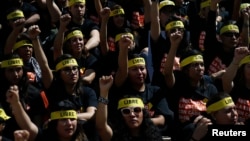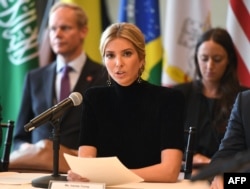From $7 for a Rohingya refugee to $750 for a North Korean “slave wife,” human rights activists have voiced concerns that it is becoming increasingly easy to enslave another human being as the cost plummets.
The average modern-day slave is sold for $90-100 compared to the equivalent of $40,000 some 200 years ago, said Kevin Bales, Professor of Contemporary Slavery at Britain’s University of Nottingham.
“There has been a collapse in the price of slaves over the last 50 years,” he told the Thomson Reuters Foundation’s annual Trust Conference in London, which focuses on women’s empowerment and modern slavery.
'Beasts of burden'
Pointing to a photo of boys hauling rocks in Nepal “like beasts of burden,” he said their parents would have sold them for $5-$10. Children are so cheap that if they get injured or fall in a ravine their slave master abandons them, Bales said.
“They understand it’s less expensive to acquire a new child than to call a doctor,” he added.
Bales attributed the fall in price to the population explosion which had “glutted the world with potentially enslavable people.”
40 million people trapped
Worldwide, about 40 million people were estimated to be trapped as slaves in 2016, mostly women and girls, in forced labor, sexual exploitation and forced marriages, with global trafficking estimated to raise $150 billion in profits a year.
North Korean defector Jihyun Park told how she was trafficked to China where she was sold for 5000 yuan ($750) to an alcoholic, violent farmer.
“He said I’ve paid for you so you must work. I spent six years as his slave,” Park said.
Thousands of North Korean women are believed to have been trafficked as wives and sex workers inside China where the one-child policy has skewed the gender ratio.
Natural disasters force issue
In Bangladesh, Asif Saleh, of development agency BRAC, said Rohingya refugee women fleeing Myanmar and arriving in Bangladesh were being sold for as little as 5 pounds ($6.60).
Aid agencies say traffickers often exploit crises to prey on vulnerable people separated from their families and communities.
Nepalese nun and kung fu teacher Jigme Wangchuk Lhamo, who helps families displaced by the country's 2015 earthquake, told the conference that people were selling their daughters, sisters and mothers to traffickers after the disaster in order to rebuild their homes.
“Some men just see girls as a bunch of money,” she said.
In northern Kenya's pastoralist region, lawyer Fatuma Abdulkadir Adan said child brides as young as nine were sold for eight cows or eight camels — worth about $800.
“Girls become commodities and they have no voice, no one asks what the girl wants,” said Adan, who uses football to help tackle child marriage and female genital mutilation.
But it is not just rich countries where girls are sold off.
Sarah, forced into prostitution as a child in Britain, said the gang who groomed her said she would have to have sex every day until she had paid off a “debt” of 75,000 pounds.
“They told me I belonged to them and until my debt was cleared I had to work for them,” she said.


